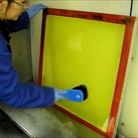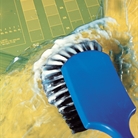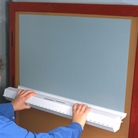Capillex 18
The wide processing latitude of Capillex 18 makes this product ideal for fine line and halftone printing with solvent based or conventional UV inks.
Features
- The high resolution and superb definition ensures that excellent print quality is achieved every time, whatever the run length. Perfectly matched for fine mesh counts, Capillex 18 is the industry choice for quality printing.
- Mesh range: 120 - 150/cm (305 - 380/inch)
Benefits
- Easy to use
- Will give consistently high quality screens for halftone printing
- Very tough
- Simple to decoat
Applications
- Ceramics
- Graphics
- Self Adhesive Decals
- Industrial marking
Additional Information
Working Instructions
Mesh Preparation
All new Polyester meshes should be first abraded with Autoprep Gel before use and all meshes should be degreased using Universal Mesh Prep immediately prior to mounting the film.
Adhering to the Mesh
For large or small screens – For best results always use the Autotype Caplicator film cassette. First cut the film to size and place the film on a dry, flat surface. Using the Anti-Static Duster, remove dust from the polyester backing film as the film is rolled, emulsion side out, around a plastic tube supplied with the Caplicator. Place the film in the cassette leaving approximately 2 cms (3/4”) unrolled. Spray the mesh with water and wipe excess water from the perimeter of the frame to avoid rivulets after adhering the film.
Contact the rolled film leading edge onto the top of the wet vertical screen and unroll the film down the screen, thus adhering it to the mesh. Remove excess moisture from the inside of the screen with a light-weight, window cleaner type squeegee. Wipe excess water from the perimeter of the frame with absorbent cloth then proceed to drying. See How to Guide – Applying Capillex to large screens
For small screens only – Method 1: Place the film emulsion side up onto a raised pad or mounting board. Gently draw down a wet degreased screen across the film to adhere it to the mesh. Then squeegee off excess water from the inside of the screen. Wipe water from the perimeter of the frame then proceed to drying. See How to Guide – Applying Capillex to small screens
For small screens only – Method 2: Place the film emulsion side up onto a raised pad and lay the dry degreased screen on top. Using a hand spray water bottle, spray water onto the mesh until the film is completely wet. Then squeegee off excess water from the inside of the screen. Wipe water from the perimeter of the frame then proceed to drying.
Drying the Screen
The screen can be dried with cold or warm air, maximum 40°C (140°F). Thorough drying is essential for optimum results. When the support has been peeled off, continue drying for a few minutes to ensure the film is completely dry. See How to Guide to Drying
Storage of Screens
After applying Capillex film to the screen and drying, the screens can be kept in the dark for up to a week before exposure, provided that reasonable temperature and humidity conditions are maintained. If storage of screens is anticipated, it is recommended that the backing sheet is not removed until the screen is about to be exposed.
Exposure
Position the positive with the emulsion in contact with the stencil and place in the printing-down frame. Light sources vary considerably in their general spectral output, therefore it is important to establish to correct exposure level. Check the exposure with the Autotype Exposure Calculator. See How to Guide to Exposure
Washout
Wash out the stencil out with a strong water spray, maximum temperature 45°C (112°F). Continue washing for one minute after the image area is clear. When washout is complete, remove excess water with newsprint or a wash leather and then dry the stencil with cold or warm air, maximum 40°C (104°F).
Blockout
Block out the area between the edge of the stencil and the frame with Regular or Blue Filler.
Stencil Removal
Clean the screen of all ink and any residues with recommended Autosolve screen wash. After rinsing the screen with water, apply Autostrip thoroughly with the Autotype Brush to both sides of the mesh and leave for 5-10 minutes for the emulsion to soften. Then brush over and rinse off with a strong water spray. The most effective removal is with a high pressure stripper. If a high pressure unit is not available, any stencil residue can be removed with Autosolve and any residual ink haze can be removed with Autokleen Plus or Autohaze Extra.
Top Tip: If you want to use a slighlty coarser mesh, or if you are printing mainly line images then Capillex 20 will give a better result.
See section 'How To Guides' below for detailed advice








